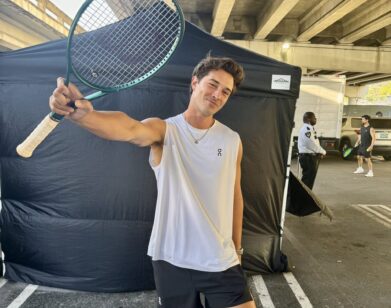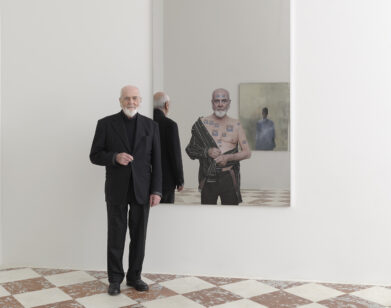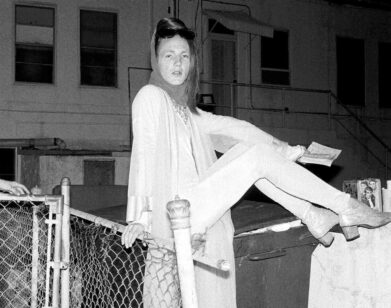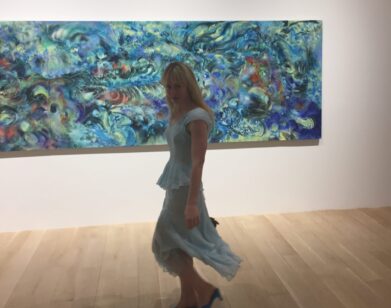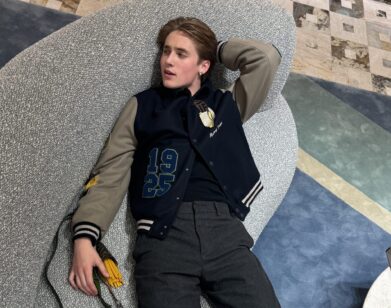Shepard Fairey Thinks Streetwear Has Gotten As Silly As A Duct-Taped Banana
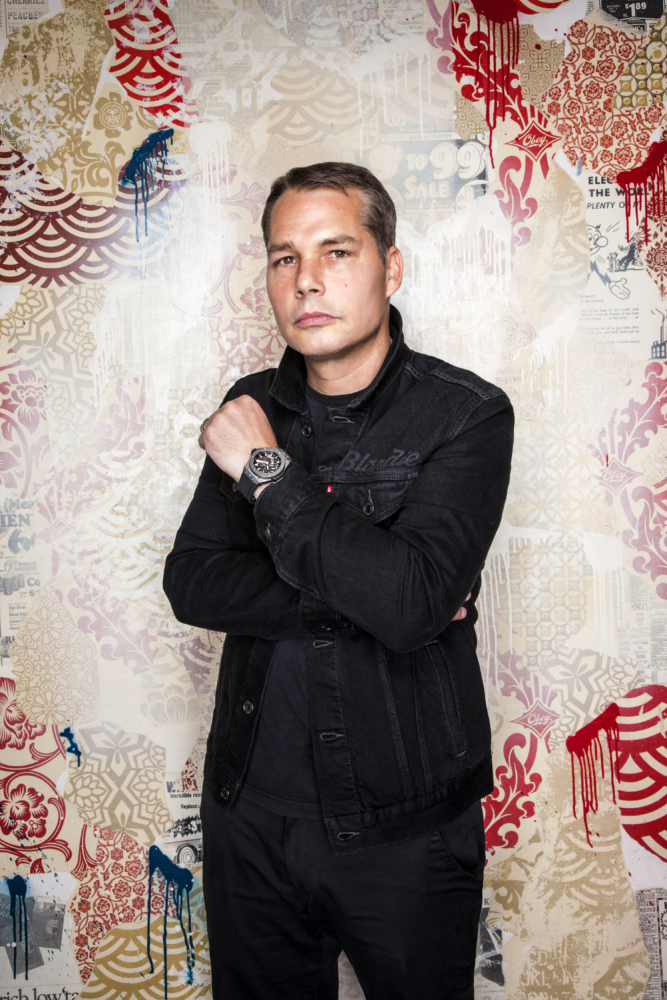
Shepard Fairey still has hope. Eleven years after the artist created what is perhaps the nation’s most recognizable poster—the Barack Obama “Hope” portrait—as a grassroots effort to support the Chicago upstart politician’s presidential ambitions, the concept of hope has teetered and wained, perhaps seeming a bit quaint in the current state of things. As we wrap up a decade in which a reality star became our president, reality itself became subject to skepticism, and fine art became a banana duct taped to a wall, Fairey is marking 30 years of making street art, his oft-political graphics now ubiquitous on t-shirts, murals, and gallery walls alike. Beginning his career with graffiti and a sticker of André the Giant that he made as a joke while a student at the Rhode Island School of Design in 1989, Fairey became a pioneer in street-wear design, founding OBEY Clothing in 2001, and a leading artist-activist with campaigns for the ACLU, the LGBT grassroots organization FAIR, and Rock the Vote, among others.
A new exhibit at the Goldman Gallery in Wynwood, which opened during this year’s Art Basel Miami, spans 30 years of Fairey’s work, much of which features the now-iconic Andre the Giant image. The graphic, which became as much a part of the American urban landscape as glass skyscrapers and chewed gum, can now be seen on a new line of luxury watches by Hublot as part of their “Hublot Loves Art” initiative. The irony isn’t lost on the street artist, who is as much an opportunist as he is a renegade. “I still to this day make $45 screen prints that are signed and I make cheap t-shirts and stickers, and then I make paintings that are many thousands of dollars,” he says. “I’m always thinking, well, if I have a million followers on Instagram, there’s seven billion people in the world—that’s quite a large percentage that have no idea who I am and what I’m doing, and I believe in what I’m doing.” Below, the artist spoke with Interview about memes, murals, and why he he hasn’t lost hope quite yet.
———
SHEPARD FAIREY: Hey, Sarah. It’s Shepard.
SARAH NECHAMKIN: Hi, how are you? I know it’s been a busy week with Basel and everything.
FAIREY: Yeah. I’m happy to be back in L.A. with just my normal intense workload. I was super busy during Basel, but even right before Thanksgiving in Miami, I went out and painted two new murals and did some touch-ups on a couple of older murals as well.
NECHAMKIN: How do you feel about Miami as a city?
FAIREY: It’s making some progress in terms of the seriousness of the art collectors year-round now. It used to be like, people come in during Basel and then they leave, and it’s not a very serious art place the rest of the time. But over however many years—it’s been 16 years or whatever since Basel moved in there—I think it’s been progressing. For where I am, which is in an interesting zone between highbrow fine art and street art, it’s been nice to see a lot of people who came to my work through street art now getting more sophisticated in looking at the fine art world too. Then the other way around, people from the fine art world that go over to Wynwood and check out all the murals there and go, “Whoa, this isn’t just vandalism. There’s some really amazing art happening.”
NECHAMKIN: As the decade wraps up, I’m thinking about how the art world has changed, and how your work has emblemized the transition of street art as it’s been absorbed into the fine art world. As a pioneer of that, what are your thoughts?
FAIREY: It’s all very complicated, but really what matters for me is authenticity. When people are doing something authentic and there’s no commercial platform for it to earn them a living, that’s really unfortunate. Then when things flip over to something becoming hyped or trendy and people go, “Oh, I’m going to get into it not for authentic reasons but because there’s commercial potential,” that’s also problematic to me. But I ask a lot from the audience. When people complain about this stuff, I go, don’t blame the opportunists, whether it’s on the gallery side or the artists’ side. Blame the audience for not keeping the pretenders in check. It comes down to the same thing for how our democracy is working. Shit is fucked right now. It’s because most voters are too ignorant to understand. They can’t separate the disinflation and the misinformation from the truth.
NECHAMKIN: Do you think that’s on the voters or the system they’re a part of?
FAIREY: It’s so dark and cynical for a lot of people to exploit the ignorance of the audience, but when you look at the kind of power-hungry narcissists that politics attracts, what else can you expect? You have to have a populace as educated enough and willing to take time away from whatever other sort of escapist pursuits to look at how they need to vote to make a positive difference in their own lives. When they don’t bother to do that, they can be easily manipulated. The same thing happens in the art world. I’d say at Basel, it’s the banana duct taped to the wall.
NECHAMKIN: I was just going to ask you about that.
FAIREY: I’m a joker, and I like to be irreverent and subversive, but I also don’t like to demean things in a way that might be harmful for anyone that’s not educated enough about all the different nuances and facets of the art world. I considered it a prank, and it’s great that somebody can make a lot of money from a prank. But for people to actually spend the money on buying a perishable piece of art and then to get all the media attention really takes a lot away from a more meaningful conversation about the role art can play. It just confirms a lot of the most negative clichés about the art world and about the pretense of artists.
NECHAMKIN: I’ve spoken to a lot of people about it and they’ll say, “I totally respect what the artist was doing and I hate the fact that someone would actually buy it.”
FAIREY: I guess it’s the idea that, I’m going to put something ridiculous out there and see whether the audience will confirm that people will buy anything that’s presented by a high-profile gallery that achieves a spectacle, because notoriety is more important than content or merit. If that was the aim of the piece, it was totally successful.
NECHAMKIN: As much as you’re pointing out the cynicism of that, you clearly understand the importance of iconography and that when you make a powerful image, it gets replicated over and over and over, for better or for worse.
FAIREY: That’s true. I’m guilty of wanting to speak a realistic language. Maybe you see something novel and it should register the first time, but I accepted that it’s going to take many more times. But I’m also very transparent about the aims of my work. With these tools of grabbing people’s attention—and you could call it propaganda of using symbols—I take the work and I explain it. I say, okay, so now that I have your attention, be cautious of the next thing that tries to get your attention using the same methods. That’s one of the things I can stand behind. A lot of people define anything with a persuasive agenda as propaganda. I agree with that in a sense, but propaganda has a really negative connotation. My visuals have an agenda, but usually the agenda is to say, here’s an alternative to what you’re usually being presented with and what you’re asked to think.
NECHAMKIN: Counter-propaganda, in a way.
FAIREY: Yeah. A lot of my graphics for posters and t-shirts say “Obey Propaganda.” It’s reverse psychology. A lot of things don’t want you to feel that you’ve been asked to submit to something or that what you’re being presented with has an agenda at all. It’s the invisible hand of persuasion. I’m making all that very visible.
NECHAMKIN: Did you ever imagine that your designs would be on luxury watches?
FAIREY: You know, what’s hilarious is that I always loved the absurdity of it. I come from punk rock and skateboarding, which are very sort of grimy cultures. But the year after I started making the original Andre the Giant stickers, I used to get a sample of a watch that you would make as your company watch from an airline magazine, and I sent in the Andre thing and my 50 bucks and bought a watch with the Andre logo on the face. I thought it was so funny to have something that normally, like if you had been in a company for 10 years, you’d get this gift—the irony of it.
I wanted to work with Hublot because they make really beautiful watches. When people say, “Oh, well your background is really street and now you’re doing things in galleries,” my background was never exclusively about the street. My philosophy has always been: I want my work to interact with people in as many places as possible. I want my work to be accessible and democratic. The street was the only outlet I had. I had to do it on a shoestring budget and without permission. But I went to art school. I was showing art pieces in cafes and warehouse spaces when I was still in school. I didn’t have an attitude that creating art pieces that could potentially be for sale was somehow a contradiction with my philosophy of art for the people. I still to this day make $45 screen prints that are signed and I make cheap t-shirts and stickers and then I make paintings that are many thousands of dollars. Then I do a collaboration with somebody like Hublot. I’ve gotten a lot of blow back from my audience for doing the collab with Hublot, but most of the criticism comes from this assumption that I’m transitioning away from accessibility by doing it. That’s a preemptive accusation. It’s not based on any reality.
NECHAMKIN: I think for your generation, that concept of selling out was much more of a principal worry. I don’t think selling out is even really a concept anymore. Everything is branded.
FAIREY: Streetwear has become luxury, but I don’t hear any of the same criticisms there. It’s just how things have shifted. It’s more exclusive and expensive than H&M or Zara, and that means that the fast fashion crowd can’t get it. I think it’s almost as silly as the duct tape banana. But that’s what’s going on. With my clothing line, I keep it affordable. It’s more expensive than what you’re going to get at one of those Forever 21s, but it’s a lot less expensive than Supreme. It’s easy to think I’m really well-known, but if I have a million followers on Instagram, there’s seven billion people in the world—that’s quite a large percentage that have no idea who I am.
NECHAMKIN: I think that speaks to your Warholian business sense as an artist, not seeing high art or art in general as existing separately from the world, and from commerce.
FAIREY: Completely. I understand why the art world likes to gatekeep, because a lot of people make a living from that. But Warhol was a huge role model for me in terms of expanding the role of art into broader culture and tackling subject matter that the art world considered mundane. But the way in which he treated it elevated it, and I’ve taken that principle and tried to push it even further. Warhol had Interview magazine. He did album covers for Billy Squier, Velvet Underground, the Rolling Stones. I think very much like him, but I’m more involved in social and political things than he was.
NECHAMKIN: Obviously, the Obama “Hope” poster was a breakthrough for you in terms of exposing a lot of people to your art. I’m wondering if you’re thinking towards 2020, and how you see that concept of hope has changed since 2008?
FAIREY: I was very lucky with the poster. It was different from most political art in that it was a graphic image that was unique enough to stand out from what had come before it, but it was also tame enough to not scare people away. Finding that balance is something that I was striving for when I created the image. But it worked much better than I thought it would. So now, if I were to create something like that again for a candidate, it would seem like it was just an imitation. And so, I have to find a way to create something special that doesn’t employ the same approach. I think every person that has ever done something that resonated culturally, if they’re intelligent, they understand that it’s a very, very fortunate thing to make something that happens to both predict and surf the wave of the zeitgeist. You can have a great idea, and yet all these other variables you have no control over will not converge harmoniously to allow the great thing you’ve done to resonate.
I do have hope. It’s a tough time right now, but I was pleasantly surprised in 2017 when I worked on the series called “We The People.” Those images were images about humanity as a common denominator regardless of your skin color, your religious background, your country of origin. That seemed like the worst possible idea when everything was about tribalism and factional hostility and division. Progress takes courage, so that’s the silver lining.
NECHAMKIN: I’m still hopeful, but I’m also reluctant. I genuinely have no idea what’s going to come out of the next year.
FAIREY: We’ll see. I’m very nervous about this coming election. This is the toughest time politically that I’ve seen in my whole life. I was listening to anti-Reagan punk rock in the ’80s and doing a lot of stuff against Bush in the early 2000s, and all of that seems so civil and progressive compared to what we’re dealing with now. Who do you like for president?
NECHAMKIN: I’m in between Elizabeth [Warren] and Bernie [Sanders].
FAIREY: I like both of them, but as far as temperament, intelligence, and maybe less likely to divide people with policies, I like Mayor Pete [Buttigieg]. I’ve met him a couple of times, and he’s really good at handling tough questions. Because he’s from South Bend, Indiana, he’s had to work with a Republican governor with a lot of constituents who are not Democrats. The policies I’d like to see implemented are very much Bernie and Elizabeth Warren. But my biggest concern is that we don’t get another four years of Trump. That’s where my idealism and my pragmatism are slightly in conflict. I was much happier in 2008 when I felt like supporting Obama, I could have my pragmatism and my idealism bundled in one guy.
NECHAMKIN: Do you think you would do a graphic for Mayor Pete?
FAIREY: Yeah, I would. I just don’t know what it would be. I’ve met with him a couple of times and we sort of talked about it loosely, but at that time he didn’t seem like he was getting that much traction and I was insanely busy. We’ll see how he does in Iowa. I’ve read his book and he’s very intelligent. I think that some of the stuff that I’ve seen circulated from the lefty crowd about like, he tore people’s houses down … Every house that he tore down in South Bend was abandoned and offered up for people to restore themselves or to have the landlords restore. There are a lot of hater attacks that are false out there. Stuff about him being racist.
NECHAMKIN: I know many people of color are not into him.
FAIREY: The racist side of the police department there, that wasn’t a culture of his creation. It’s not easy to undo. He talks about race in a really sophisticated way, but he also can’t completely dismantle his own police department without sounding like he’s pro-lawlessness. But people are sort of cherry picking things that could be used to discredit him. Nobody’s perfect. The cool thing is he’ll acknowledge it. He said in a debate something like, “Yeah, I’ve been trying to fix the racial disparity in the police department and I haven’t been able to achieve it yet. It’s something that I’m still working on.” Have you heard that much honesty from many of the other candidates? Never from Trump, especially, but anyway.
NECHAMKIN: Do you think it’s possible to recreate the kind of fervor that people had around Obama with any of the current candidates? There’s a lot of excitement surrounding Bernie, especially among young people.
FAIREY: I’m friends with Ben Cohen, the co-founder of Ben and Jerry’s, and he’s one of the main fundraiser guys for Bernie. He’s thinking very strategically about who to wrangle. He hit me up about supporting Bernie and I told him the same reasons I told you why I wasn’t supporting Bernie at this point. I think that Bernie’s biggest challenge is age. The idea that he would be endorsed by younger people like AOC or by celebrities I think makes a lot of sense strategically for him.
NECHAMKIN: So what’s next for you?
FAIREY: This year was the 30th anniversary of me starting in street art, but I’m not slowing down. I’ve got a big collaboration with the ACLU to do some murals in different battleground states next year. I’m motivated to make art that I hope can make a difference and turn people out to vote. The commercial side of what I do is great because it gives me freedom to spend money on projects I want to do around my ideals. Murals interact with a wide audience. For as many ways as people can easily make imagery, create memes, et cetera, the ones that don’t feel throwaway are the ones that I think can move the needle more. There’s something worthwhile in quality, not just quantity. The relationships that you form with other people, the time that you put into good literature or following politics—all of that should be on the mural level, not the meme level.

